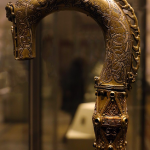Seems fitting for the day!
On November 24, 1713, Miguel Jose Serre i Ferrer, son of Antoni and Margarita, was born in Petra, Mallorca, Spain and baptised at San Bernardino Church.
Junípero Serra took his baptismal promises very seriously and lived them to a heroic degree. He knew struggle and overcame them, giving all thanks to the “light [that] shines in the darkness” (Jn 1:5).
Serra’s life is a miracle. He was not even expected to live a few days. We know this because of his baptism—just hours after he was born. He went on to be a great academic in Mallorca, Spain, but heeded the call to be a missionary abroad. He left the comforts of home and knew he would never return. By the time he set foot in present-day California he was a very old man. He was 5’2”, short even for his day, traveling thousands of miles mainly by walking (on an often ulcerated leg), was asthmatic, and averaged 4-5 hours of sleep a night. He would struggle against all odds to bring the gospel to this corner of the world. He ended up living 70 years, twice the average lifespan for his day. He is still studied some three-hundred plus years after his birth.
I went on my own personal fifteen year quest to get closer to the truth about the eighteenth century Hispanic Franciscan priest. Throughout the process my understanding and appreciation of Serra was truly deepened. I was able to see Serra in a clear, concise way and as one I walk humbly with on my faith journey. His story includes powerful witness to love, mercy, courage, perseverance, fidelity, sanctity, dedication, pain, joy. In my research I uncovered the powerful witness of Sister Dyrda, the nun miraculously cured in 1960 of lupus after praying to Serra. Thomas G. Keene of the San Francisco Chronicle interviewed her September 16, 1987 at Carmel Mission Basilica, the day before Pope John Paul II’s visit. She said, “I only know that he [Serra] was a very saintly man and I pray to him every day.” She then walked over to the thirty Native Californian protesters and prayed with them.
When Pope Francis announced the canonization of Junípero Serra in January, I followed media reports very closely. Some opposed his canonization—like the California Senators who supported the removal of the Junípero Serra statue at the U.S. Capitol, a Monterey city councilwoman going on record opposing Serra’s sainthood (she incorrectly referred to him as Sierra multiple times), and people who have referred to him as the Devil, Himler, and a white supremacist. They have also reported on the reasons why Pope Francis refered to Serra as the “Evangelizer of the West”, Bishop McElroy of San Diego a “foundational figure”, and Governor Jerry Brown “ . . . one of the innovators and pioneers . . .” in California history.
How does one make sense of all this?
When Junípero Serra was canonized at the Basilica of the National Shrine of the Immaculate Conception, the national and patronal Catholic Church of the United States, in Washington, D.C. on September 23, 2015, the Church was not celebrating the catastrophes that came with cultural exchange, but a man who rose above the norms of his day and lived a life well-lived—one devoted to Christ and love of neighbor.
Serra’s life was not so black and white. Someone left this review online of my treatise on Serra; “A short primer that leaves me wanting to know more about Junípero Serra.” I pray that more will want to learn about the man I call a great friend. He will inspire.
Saint Junípero Serra, pray for us!
Christian Clifford is the author of Saint Junípero Serra: Making Sense of the History and Legacy. He teaches high school theology in San Mateo, California. For more information, visit www.SaintSerraBook.com.















